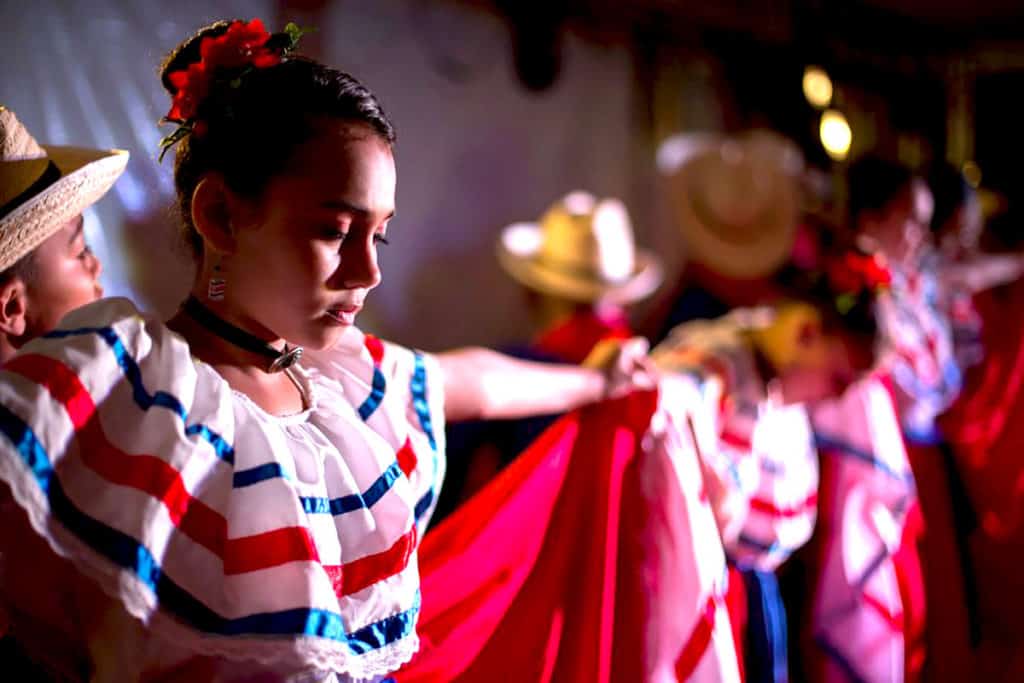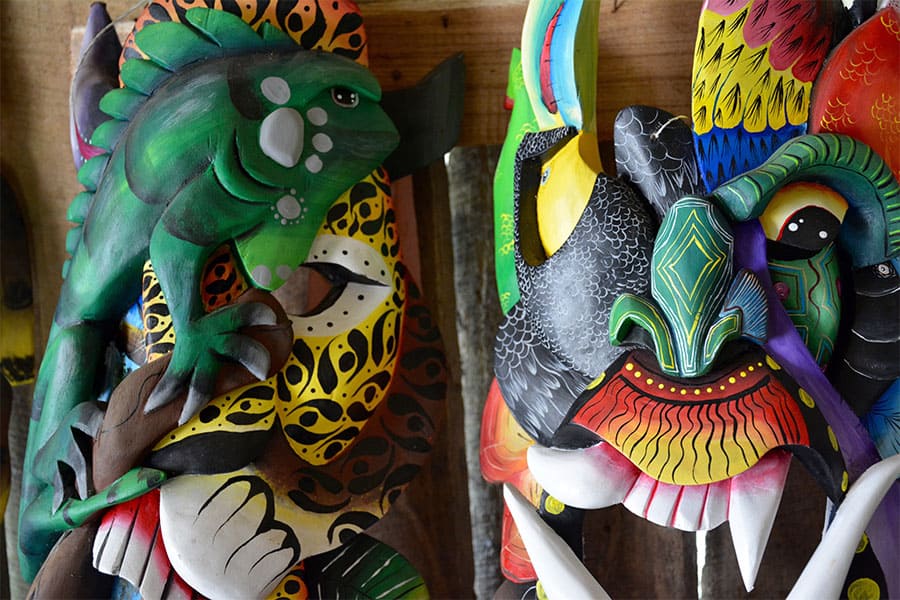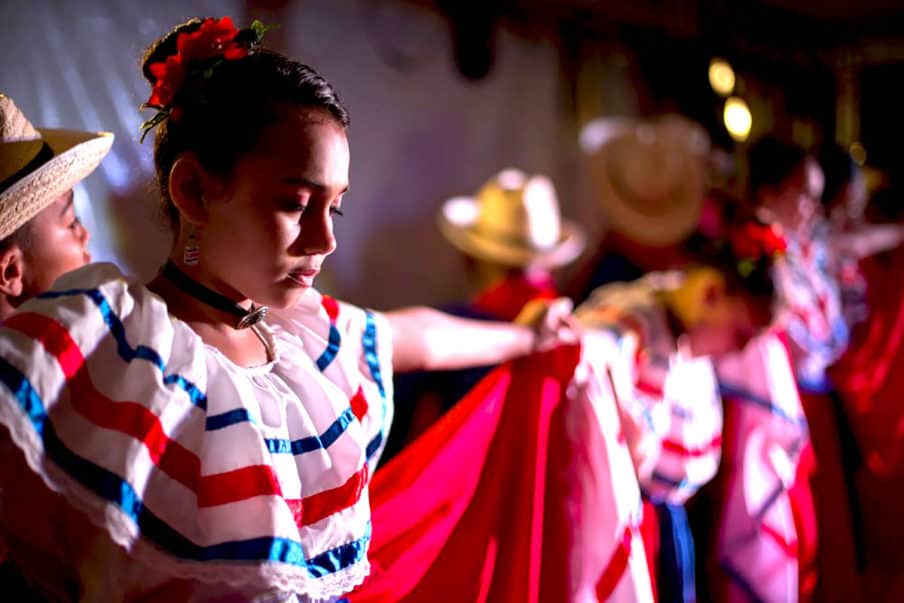
The traditional Costa Rica dances and folklore are Punto Guanacasteco, Suin Criollo La Yeguita Diabloe and Chorotega. They all tell a story about the history of Costa Rica and its people.
Every culture in the world has their own folkloric dance, and Costa Rica is no exception to this. Traditional folkloric dancing in Costa Rica is a way to pass on its people’s culture and traditions, It not only is wonderful expression of Costa Rica but is also a way of telling a story.
Watching any one of these Costa Rica Folkloric dances is both fun and educational so here is a brief look into Costa Rica’s traditional dances and folklore, what they represent and how they came to be.
The History of Costa Rica’s Folkloric Dances
It may sound a bit stereotypical, but people living in Latin America not only love to dance but are pretty good at it. Costa Ricans are no exception to this rule.
Although many of their folkloric dances have European and African influence, these traditions go back for hundreds of years, even before the Spanish first landed on Costa Rica’s shores. Some of the older dances were developed by pre-Columbian natives older than even the Aztecs.
Eventually, when the Spanish did colonize Costa Rica, they added their own flavor to the music that accompanied these dances. Even the African slaves that the Europeans brought over added their own influence. This eventually amalgamated into the traditional dances Costa Rica has today, each steeped in the centuries-worth of history, culture, and legends of the land.
Costa Rica’s Traditional Folkloric Dances
Costa Rica’s folkloric dances are very entertaining to look at and are very festive. You’ll see them being performed during celebrations and festivals, and in tandem with their very colorful costumes, are a feast for the eyes. Here are some of the most popular folkloric dances in Costa Rica
1. Punto Guanacasteco
Punto Guanacasteco is considered to be Costa Rica’s most popular traditional dance, so much so that many consider it to be the country’s national dance. The dance itself is meant to reflect the traditional rites of courtship amongst young men and women.
The dancers form a circle, with the men surrounding the women. They begin dancing around the room, with the women’s skirts flaring and waving as they dance with their respective partners.
The men will then follow suit, whilst fanning their hats, waving their scarves, and even shout out verses. The bright colors of the costumes as they flare about alongside the energetic music and the racy rhymed verses is meant to represent the flamboyant way Costa Ricans would go about flirting.
2. Suin Criollo
Suin Criollo, otherwise known as Swing Criollo, is a traditional dance that is relatively younger than the other folkloric dances. This dance unique to Costa Rica is actually derived from the popular swing dances of the United States.
The dance steps were of course, adjusted to suit Costa Rica’s traditional music. What makes this dance even more unique is that the traditional dance community looked down on this dance and at one point during the 1970’s, was even prohibited in many dance halls in Costa Rica.
It wasn’t until the 2000’s until this dance was eventually given folkloric dance status and is now part of Costa Rica’s identity.
3. La Yeguita
La Yeguita, which means The Little Mare, is a traditional folkloric dance that is performed in Costa Rica on every 12th of December. The dance is a celebration of the Virgin of Guadalupe, which takes place in Nicoya. La Yeguita is a tradition derived from a native legend concerning the rivalry of twin brothers.
On December 12, 1653, the two brothers had an argument over a woman they both fell in love with named Nantiume. The fight eventually escalated, and both were in danger of killing one another.
The people of their village were terrified, and so they prayed to the Virgin of Guadalupe to intervene. Out of nowhere, a black mare appeared and came between the two brothers, ending their fight. This was seen as a sign of divine intervention and has since then been celebrated by the locals for centuries.
4. Danza de los Diablitos
The Danza de los Diablitos, or the Dance of the Little Devils, is an annual tradition that lasts 3 days, performed in New Year’s Eve to January 2 by the native Boruca tribe. This dance involves the use of elaborate costumes and masks the by male members of the tribe.
The ritual dance is meant to re-enact the Spanish invasion of Costa Rica, who are represented by a fake bull. After each festival, the masks are then sold by the Boruca people along with many handmade crafts to help their tribe.
5. Chorotega
The Chorotega is a dance mainly performed for tourists nowadays and are accompanied by folkloric stories and legends of Costa Rica, from the stories of its people, its coffee farmers, even to the tragic legends of lovers from the ancient past.
Chorotega itself is composed of two separate dances, namely the Danza del Sol, or the Dance of the Sun, and the Danza del Luna, the Dance of the Moon. This tradition is a great example of using dance as a way to share Costa Rica’s traditions and culture to the modern era.
Traditional Costa Rica Dance Costumes

Although the dances themselves are a huge part of Costa Rica’s folkloric dances, what makes these traditions stand out are the costumes themselves. Each type of dance has their own unique costume, and each one is as colorful as the next.
Much like the dances themselves, these costumes have also been influenced by various European and African designs as well, with many native Costa Rican design choices visible as well. Here are some of the costumes used in these folkloric dances.
Golas
The centerpiece for the Punto Guanacasteco dance is the women’s dresses, otherwise known as the goals. Each of these dresses are characterized by bold colors on their long skirts. When fanned and waved, these skirts create a festive kaleidoscope of colors and movements.
Boruca Masks
These intricate masks are an important component of the Danza de los Diablitos. They are made from balsa wood and are painted to be as colorful as possible. The Boruca tribe have been known to create wonderful pieces of art, not just with woodcraft, but with their weaving as well. These masks are a showcase of the tribe’s artistic traditions.
Final Thoughts
Dancing has always been a way to express something physically. It’s a medium to pass on certain ideas, much like through songs, paintings and poetry.
Any trip to Costa Rica should include a Folkloric Dance show. Not only is it entertaining but it also gives you a greater appreciation of Costa Rica culture and its colorful past. Its also good to support those people and organizations that are trying to keep the Costa Rica traditions alive for future generations.

